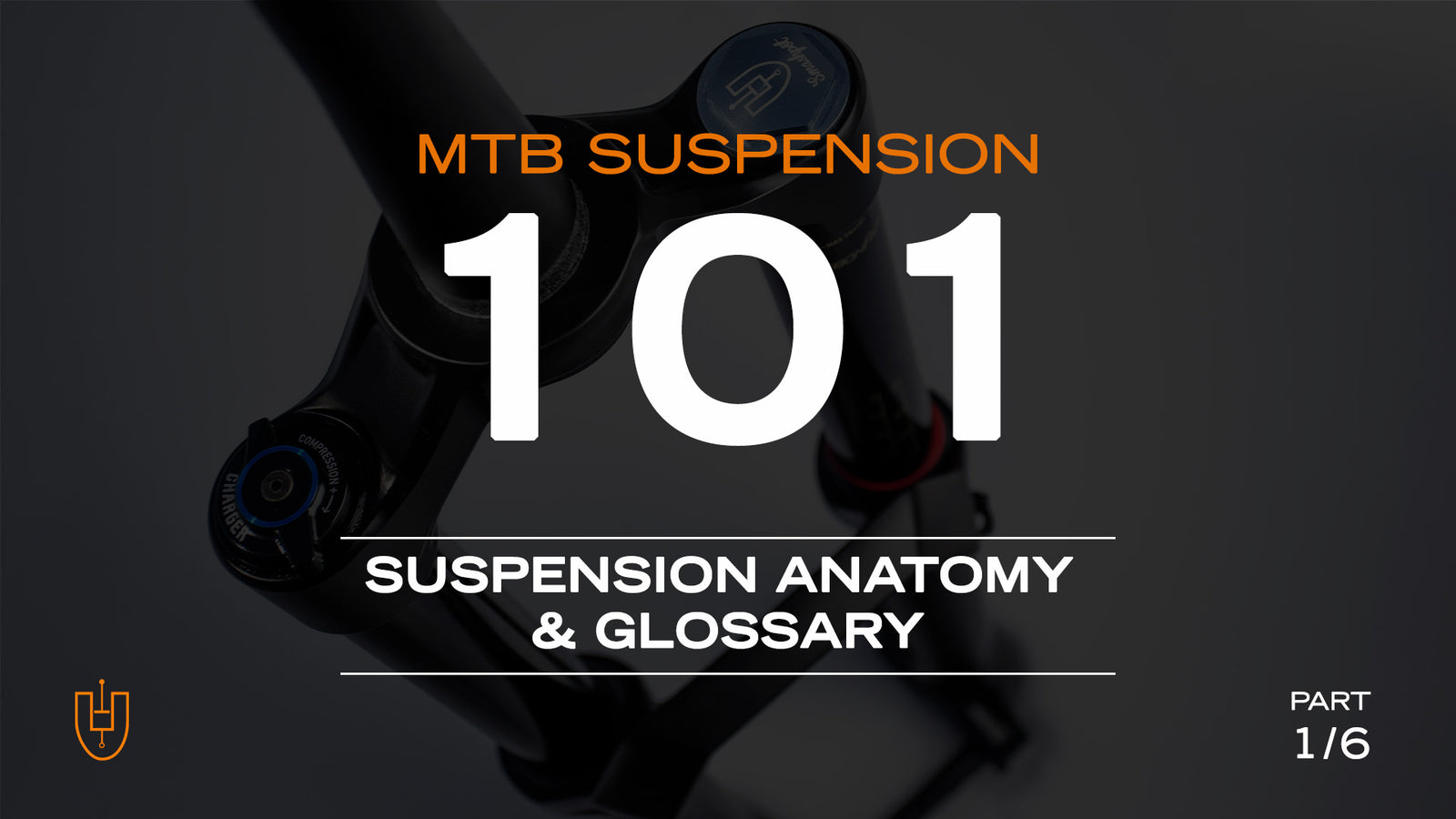MOUNTAIN BIKE SUSPENSION 101: Suspension Anatomy & Glossary (Part 1 of 6)

If you know very little about suspension, you’ve come to the right place.
Suspension tech has come a long way over recent years, and it goes without saying that the more we expand our understanding of how it works, the better we will be able to use these often expensive, springy bits of equipment at their fullest potential. When everything is working as intended, you’ll be riding smoother and with more control (and faster, because faster is ‘funner’, right?).
With this 101 series we’re going right down to the basics, because growing your understanding of suspension will be easier with a solid foundation.
General Suspension Glossary
Suspension does much more than make our life less bumpy. When working as intended, it can also provide extra traction in chundery sections and support when landing off jumps and drops. At the end of the day, you’ll experience improved comfort and maybe even more confidence, knowing that your bike is not trying to kill you.
Before we dive into talk about suspension, there are some basic concepts and definitions we need to cover.
(Feel free to skip ahead if you already know this stuff.)
|
Fork |
The name of the suspension unit on the front of your bike, that your front wheel attaches to. Rigid forks exist, however for the purposes of these articles, we’re only talking about suspension forks. |
|
Shock |
The term used to refer to the rear suspension's damper/spring unit on a bike. |
|
Spring |
The spring maintains the suspension system at a predetermined height and holds up the bike/rider's weight. It lets the wheel move relative to the rider, but tries to hold the rider and the wheel a certain distance apart on average. Typically springs are compressed air or metal coils in the mountain biking world. More on this in the following articles. |
|
Damper |
A system that controls the movement in a fork or rear shock by forcing oil through small holes. |
|
Travel |
The distance that a suspension fork, or frame with rear suspension, can compress. The frame’s travel is determined by its leverage ratio (design) and the shock’s stroke. |
|
Stroke |
The distance that a shock (rear suspension) can compress. Not to be confused with how much a frame with rear suspension can compress. |
Suspension commonly comprises a spring and a damper.
Fork Nomenclature

|
Dropouts |
Where the wheel attaches to the fork.
|
|
Steerer Tube |
The part of the fork that goes through the headtube on your frame and that the stem clamps onto. There are other sizes / standards out there - most common steerer tubes these days are tapered: 1 1/8” at the top where the stem clamps, and 1.5” at the bottom where it connects into the rest of the fork. Older forks may have straight steerers 1 1/8” or 1.5” in diameter. |
|
Stanchions |
The part of the fork that slides into the lowers. It is also the part you’re told to not get scratched. Different forks have different stanchion diameters, as it directly affects the stiffness of a fork. You’ll generally find the biggest stanchion diameters on downhill forks, and the smallest stanchion diameters on cross country forks.
|
|
CSU |
Stands for Crown/Steerer/Uppertube assembly, which refers to the Steerer Tube, Crown, and Stanchion assembly as a whole. It's press-fit together to be effectively one piece. |
|
Lowers |
The bottom leg of the fork, where the wheel and brake attach. |
|
Air Valve |
The valve, usually hidden below a cap at the top of the fork, that allows you to adjust air pressure in your fork's air spring. |
|
Compression Adjustments |
The part of the fork where you can adjust your compression settings on your damper. There are many ways this can be adjusted but commonly you’ll see a "low speed compression" adjustment, and possibly either a "high speed compression" adjustment or a lockout-esque mode switch. More on this in the following articles. |
|
Rebound Adjustments |
The part of the fork where you can adjust your rebound settings on your damper. Most commonly you’ll see one adjustment available, however some forks have both a high speed and low speed adjustment. More on this in the following articles. |
Shock Nomenclature

|
Eyelets |
Where the shock attaches to the frame. Mounting types include:
|
|
Hardware |
Often called "reducers", these pieces are installed into your shock eyelet to fit the frame and are specific to the dimensions of your frame. |
|
Compression Adjustments |
The dial where you can adjust the compression settings on your damper. There are many ways this can be adjusted but commonly you’ll see a low speed and sometimes also a high speed adjustment. Some shocks require use of a tool to turn the adjuster dial, some dials can be turned by hand. |
|
Rebound Adjustments |
The part of the shock where you can adjust the rebound settings on your damper. Most commonly you’ll see one adjustment available, however some forks have both a high speed and low speed adjustment. |
|
Air Valve |
The valve that allows you to adjust air pressure in your air spring. |
|
Air Can |
The largest "body" of an air shock, which holds the volume of air and which the air piston slides through. It can be one piece, or a multi-piece assembly. |
|
Air Shaft |
The part of an air shock that slides into the air can when compressed. This usually doubles up as the damper tube, also called the damper body. |
|
Stroke Length & Eye to Eye Length |
Shocks typically have two separate measurements associated with them—the eye-to-eye length, and the stroke length. The eye-to-eye length is the total distance between the two mounting ends of the shock (measured center to center). The stroke length is how much the shock can compress. The stroke length and leverage ratio of the frame determine the frame’s overall travel. |
|
Coil Spring |
The metal spring component of a coil shock. |
|
Damper Shaft |
The part of a shock that slides into the damper body when compressed. It connects the main damper piston to one eyelet of the shock. |
|
Damper Body |
The main tube of a coil or air shock that the damper piston slides inside. On most air shocks, the damper body/tube also doubles up as the air spring shaft. |
|
Preload Adjustment Collar |
The part of a coil shock that holds and pre-loads the coil spring to the rest of the shock. It also helps account for springs of differing lengths. |
|
Piggyback Reservoir |
Can be present in both coil and air sprung shocks. Not all shocks have this. It allows for more oil volume, as well certain external adjustments that aren’t otherwise practical , by giving the oil somewhere to go after it’s flowed through an adjuster. Generally you’ll find these on more gravity-oriented bikes, as they add a bit of weight and cost compared to in-line shocks that don’t have the piggyback reservoir. |
Next:
Part 4/6 - Understanding Rebound Damping
Part 5/6 - Understanding Compression Damping
Part 6/6 - Servicing & Maintenance

